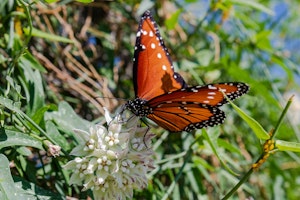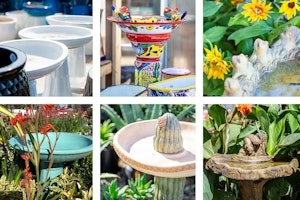 Be Inspired Blog - Arizona
Be Inspired Blog - Arizona

Creating a Pollinator Friendly Environment
For the Butterflies, Hummingbirds & Bees!
In recent years, the importance of pollinators in our gardens and landscapes has gained widespread attention. Bees, butterflies, and hummingbirds are among the most recognized pollinators, not only for their role in supporting plant and food growth but also for the joy they bring as we observe them fluttering about in our outdoor spaces.

Native Plants
One key factor in attracting and supporting these pollinators is the use of native plants. Native plants are uniquely adapted to local climates and ecosystems, providing the ideal food sources and habitats for local pollinators. By incorporating native species into your garden, you help create a sustainable environment where pollinators can thrive, ultimately benefiting both your garden's health and the wider ecosystem. Plus, native plants also require less water and maintenance (once they're established), making them a practical and eco-friendly choice. Click the button below to explore pollinator-attracting native plants.
Butterflies
Who doesn't enjoy watching butterflies flutter and perch in their garden? There are many plants that attract butterflies beyond the well-recognized milkweed and butterfly bush.
If you’re looking to create your very own butterfly habitat/garden, click on the following links to learn more:
- Attract Butterflies with these (19) Beautiful Plants
- How to Build Your Garden to Support Butterflies
Hummingbirds
Hummingbirds are a favorite among pollinators and birds, and can be attracted to your garden through hummingbird nectar and hummingbird feeders, as well as through plants that attract hummingbirds:
- How to Attract Hummingbirds to your Garden Landscape (including hummingbird feeders)
- 27 Plants Hummingbirds Love
Bees
Did you know, there are 20,000 species of bees—in addition to the honey bee? Learn more about wild native bees by clicking the link below.
Want to learn more?

- Is there a specific type of pollinator you would like to attract—bee, butterfly, hummingbird, etc.?
- There are several types of plants that are key to creating a successful pollinator habitat:
- Plants that attract pollinators and provide them with food/nectar
- Plants that provide a safe growing habitat for these key insects and birds
- Plants to avoid—that deter pollinators
- Balancing your garden with plants that provide for pollinating insects during each stage of their development. For example, did you know that there are 4 stages in both a bee’s and a butterfly’s life cycle? The egg, the larvae (grub in bees; caterpillar in butterflies), the pupa (chrysalis in butterflies) and the adult bee or butterfly. Different plants support different life stages.
- Organic Gardening: Organic gardening and landscape care can assist in the growth of these beneficial insects and birds, as well as in keeping them nearby and thriving.
 Water for pollinators to drink and bathe in. Your local SummerWinds Nursery has a wide selection of birdbaths. Choose from solid-color ceramics, Talavera, and cast stone.
Water for pollinators to drink and bathe in. Your local SummerWinds Nursery has a wide selection of birdbaths. Choose from solid-color ceramics, Talavera, and cast stone.
You can read more in the in-depth regional guide, "Selecting Plants for Pollinators," developed by the Pollinator Partnership and NAPPC. This regional guide was created for farmers, land managers, and gardeners in the American Semidesert and Desert Province, including the states of California and Arizona, and parts of Nevada and Utah.
Stop by your local SummerWinds Nursery and speak with one of our Trusted Garden Advisors to learn more about what plants work best in the Valley of the Sun to attract specific pollinators to your garden landscape.




